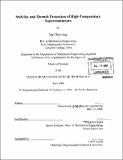| dc.contributor.advisor | Yukikazu Iwasa. | en_US |
| dc.contributor.author | Ang, Ing Chea | en_US |
| dc.contributor.other | Massachusetts Institute of Technology. Dept. of Mechanical Engineering. | en_US |
| dc.date.accessioned | 2007-01-10T16:58:55Z | |
| dc.date.available | 2007-01-10T16:58:55Z | |
| dc.date.copyright | 2006 | en_US |
| dc.date.issued | 2006 | en_US |
| dc.identifier.uri | http://hdl.handle.net/1721.1/35665 | |
| dc.description | Thesis (S.M.)--Massachusetts Institute of Technology, Dept. of Mechanical Engineering, 2006. | en_US |
| dc.description | Includes bibliographical references (leaves 83-84). | en_US |
| dc.description.abstract | In the design and operation of a superconducting magnet, stability and protection are two key issues that determine the magnet's reliability and safe operation. Although the high-temperature superconductor (HTS) is considered much more stable than the low-temperature superconductor (LTS), it is susceptible to damage caused primarily by three events that can occur in large-scale "real" devices: 1) overheating; 2) high voltage; and, 3) overstressing. In this thesis, we have investigated the first two issues as well acoustic emission (AE) technique as a possible mean for an early detection of a quench. For most of the experimental work reported here, we used "pancake" coils wound with coated YBCO conductor, the HTS of choice by those currently developing HTS-based electric power devices, though, YBCO itself to date is still in the development phase. For protection against overheating, an HTS magnet assembled with pancake coils may be made self-protecting through speedy 2-D or even 3-D normal zone propagation (NZP) within its winding, aided by good thermally-diffusive turn-to-turn spacers. | en_US |
| dc.description.abstract | (cont.) We have found experimentally that good thermal diffusivity alone, however, does not guarantee fast 2-D NZP: thermal contact resistance between winding layers plays a crucial role in NZP in the transverse direction. For high internal voltage, a small test "magnet" consisting of two pancake coils was studied to investigate the internal voltage distributions within the magnet when one of the pancakes was driven normal with a heater. Measured voltage distributions were compared with those of simulation. Finally, to complement standard resistive voltage technique, an acoustic emission (AE) technique was investigated for detection of a quench at an instance earlier than that possible with a resistive voltage technique. With improved understanding of these issues, we should be able to develop protection techniques that ensure reliable and safe operation of HTS devices. | en_US |
| dc.description.statementofresponsibility | by Ing Chea Ang. | en_US |
| dc.format.extent | 88 leaves | en_US |
| dc.format.extent | 3575709 bytes | |
| dc.format.extent | 3579331 bytes | |
| dc.format.mimetype | application/pdf | |
| dc.format.mimetype | application/pdf | |
| dc.language.iso | eng | en_US |
| dc.publisher | Massachusetts Institute of Technology | en_US |
| dc.rights | M.I.T. theses are protected by copyright. They may be viewed from this source for any purpose, but reproduction or distribution in any format is prohibited without written permission. See provided URL for inquiries about permission. | en_US |
| dc.rights.uri | http://dspace.mit.edu/handle/1721.1/7582 | |
| dc.subject | Mechanical Engineering. | en_US |
| dc.title | Stability and quench protection of high-temperature superconductors | en_US |
| dc.type | Thesis | en_US |
| dc.description.degree | S.M. | en_US |
| dc.contributor.department | Massachusetts Institute of Technology. Department of Mechanical Engineering | |
| dc.identifier.oclc | 76813505 | en_US |
